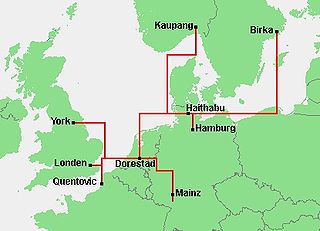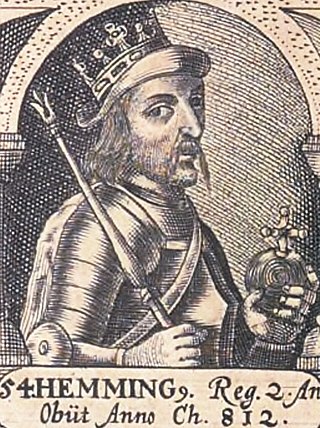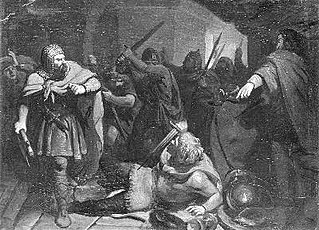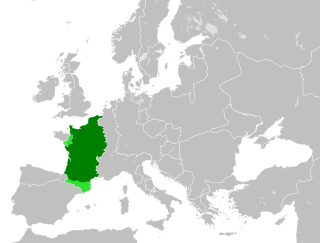
Lothair I or Lothar I was emperor, and the governor of Bavaria (815–817), King of Italy (818–855) and Middle Francia (840–855).

Dorestad was an early medieval emporium, located in the southeast of the province of Utrecht in the Netherlands, close to the modern-day town of Wijk bij Duurstede. It flourished during the 8th to early 9th centuries, as an important port on the northeastern shipping routes due to its proximity to the fork in the Rhine, with access to Germany via the Nederrijn, to the southern Netherlands, northern France, and England, and to the northern Netherlands, northern Germany, and Scandinavia.

Danegeld was a tax raised to pay tribute or protection money to the Viking raiders to save a land from being ravaged. It was called the geld or gafol in eleventh-century sources. It was characteristic of royal policy in both England and Francia during the ninth through eleventh centuries, collected both as tributary, to buy off the attackers, and as stipendiary, to pay the defensive forces. The term danegeld did not appear until the late eleventh century. In Anglo-Saxon England tribute payments to the Danes was known as gafol and the levy raised to support the standing army, for the defense of the realm, was known as heregeld (army-tax).

Hemming I was a king in Denmark from 810 until his death. He was the successor of King Gudfred, his uncle.
Bernardof Septimania (795–844), son of William of Gellone, was the Frankish Duke of Septimania and Count of Barcelona from 826 to 832 and again from 835 to his execution. He was also count of Carcassonne from 837. He was appointed to succeed his fellow Frank Rampon. During his career, he was one of the closest counsellors of the Emperor Louis the Pious, a leading proponent of the war against the Moors, and opponent of the interests of the local Visigothic nobility.

The Royal Frankish Annals, also called the Annales Laurissenses maiores, are a series of annals composed in Latin in the Carolingian Francia, recording year-by-year the state of the monarchy from 741 to 829. Their authorship is unknown, though Wilhelm von Giesebrecht suggested that Arno of Salzburg was the author of an early section surviving in the copy at Lorsch Abbey. The Annals are believed to have been composed in successive sections by different authors, and then compiled.

Rorik was a Danish Viking, who ruled over parts of Friesland between 841 and 873, conquering Dorestad and Utrecht in 850. Rorik swore allegiance to Louis the German in 873. He was born in Denmark around 800. He died at some point between 873 and 882.

Godfrid, Godafrid, Gudfrid, or Gottfrid was a Danish Viking leader of the late ninth century. He had probably been with the Great Heathen Army, descended on the continent, and became a vassal of the emperor Charles the Fat, controlling most of Frisia between 882 and 885.

In medieval history, West Francia or the Kingdom of the West Franks refers to the western part of the Frankish Empire established by Charlemagne. It was the forerunner of the future Kingdom of France and existed from 843 to 987. West Francia emerged from the partition of the Carolingian Empire in 843 under the Treaty of Verdun following the death of Charlemagne's son, Louis the Pious. It is considered the first separate polity in French history.
Hugh was the count of Tours and Sens during the reigns of Charlemagne and Louis the Pious, until his disgrace in February 828.
Harald 'Klak' Halfdansson was a king in Jutland around 812–814 and again from 819–827.
The Stellinga or Stellingabund was a movement of Saxon frilingi (freemen) and lazzi (freedmen) between 841 and 843. These were the middle two Saxon castes, below the nobility and above the unfree. The aim of the Stellinga was to recover those rights the two castes had possessed before their conversion from Germanic paganism in the 770s. At that time they had still possessed political privileges, but Charlemagne, having won over to his cause the Saxon nobility, had reduced them to mere peasants. The Stellinga thus despised the Lex Saxonum, which had been codified by Charlemagne, preferring to live in accordance with ancient and unwritten tribal custom. The movement was violently resisted by the uppermost caste, the nobiles (nobility), not always with the support of the Frankish kings.

Otgar, also spelled Odgar or Otger, was the archbishop of Mainz from 826 until his death.
Godfrid Haraldsson was the son of the Danish king Harald Klak. In 826 he was baptized together with his parents in Mainz in the Frankish Empire, with crown prince Lothair standing as a godparent.
Rodulf Haraldsson, sometimes Rudolf, from Old Norse Hróðulfr, was a Viking leader who raided the British Isles, West Francia, Frisia, and Lotharingia in the 860s and 870s. He was a son of Harald the Younger and thus a nephew of Rorik of Dorestad, and a relative of both Harald Klak and Godfrid Haraldsson, but he was "the black sheep of the family". He was baptised, but under what circumstances is unknown. His career is obscure, but similar accounts are found in the three major series of Reichsannalen from the period: the Annales Bertiniani from West Francia, the Annales Fuldenses from East Francia, and the Annales Xantenses from Middle Francia. He died in an unsuccessful attempt to impose a danegeld on the locals of the Ostergo.
A Dane named Hemming was a count in the area of Rüstringen in East Frisia in the 9th century. He and some others of his family were installed in this region by Emperor Lothair I.
Halfdan was a leading person among the Danes and the first known Scandinavian to enter Frankish service. Onomastics links him to the Danish royal family since the name "Halfdan" was commonly employed both historically and in the legendary royal lineage.
Hemming Halfdansson was "of the Danish race, a most Christian leader". He was probably a son of Halfdan, a leading Dane who became a vassal of Charlemagne in 807. He was probably related to the Danish royal family, as "Hemming" was one of their favoured names. The onomastic evidence includes the Danish king Hemming I and then a Hemming II, who was recalled to Denmark from Francia by his brothers Harald Klak and Reginfrid after Hemming I's death. This Hemming was probably the same person as Hemming Halfdansson. He probably soon returned to Francia, since there is no evidence of him in Danish politics after he and his brothers were driven out by the sons of Godfrid in 813.
Reginfrid was a co-King of Denmark from 812, when Hemming I died, to 813, when he and his brothers were ousted by the sons of a previous king, Gudfred. He was probably a son of Halfdan, a Danish leader who became a vassal of Charlemagne in 807, and brother of Anulo, Hemming, and Harald Klak. He was probably also related to the Danish king he succeeded.
The history of Christianity in Denmark started with Saint Willibrord's unsuccessful mission among the Danes in the early 8th century.